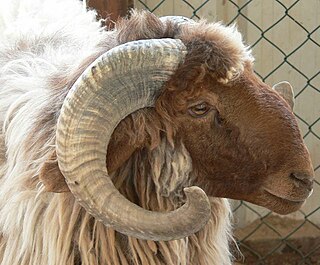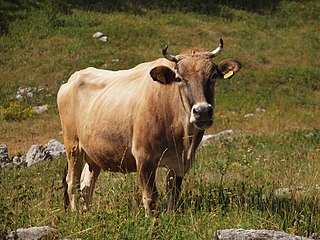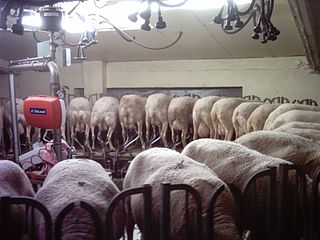
Trøndelag (Urban East Norwegian:[ˈtrœ̂ndəˌlɑːɡ]; or Trööndelage is a county in the central part of Norway. It was created in 1687, then named Trondhjem County ; in 1804 the county was split into Nord-Trøndelag and Sør-Trøndelag by the King of Denmark-Norway, and the counties were reunited in 2018 after a vote of the two counties in 2016.

Afikim is an Israeli kibbutz affiliated with the Kibbutz Movement located in the Jordan Valley three kilometers from the Sea of Galilee. It is within the jurisdiction of the Emek HaYarden Regional Council. In 2021 it had a population of 1,498.

The Awassi is a local fat-tailed sheep breed in South-West Asia originated in the Syro-Arabian desert. Other local names can also be Arab, Baladi, Deiri, Syrian, Ausi, Nuami, Gezirieh, or Ivesi (Turkish). It is multi coloured: white with brown head and legs. The ears are long and drooping.

The Fries Melkschaap is a Dutch and German breed of dairy sheep. It originates in the Frisia region, which includes parts of both northern Holland and north-western Germany. It has many names: the German stock is known as the Ostfriesisches Milchschaf, or in English as the East Friesian, the East Friesland Milch or the German Milksheep, while the Dutch equivalent is known as the Friesian Milk or Friesian Milksheep, or less often as the Friesian or West Friesian. Under suitable management conditions, it is among the highest-yielding of dairy sheep breeds.

The Buša or Busha is a breed or group of breeds of small short-horned cattle distributed in south-eastern Europe, principally in Albania and the countries of the former Yugoslavia – Bosnia and Herzegovina, Croatia, Kosovo, Macedonia, Montenegro and Serbia. Related breeds include the Gurgucke, Lekbibaj and Prespa of Albania, the Gacko of Bosnia and Herzegovina, the Greek Shorthorn, the Metohija Red of Kosovo and the Rhodope Shorthorn of Bulgaria.

Sheep's milk is the milk of domestic sheep. It is commonly used to make cultured dairy products, such as cheese. Some of the most popular sheep cheeses include feta (Greece), ricotta (Italy), and Roquefort (France).

The Clun Forest is a breed of domestic sheep originating from the area surrounding the Clun Forest in Shropshire, England. Similar to many of the British breeds of upland sheep, Clun Forest are hardy, adaptable, good foragers, and are long–lived. With sleek heads and wide pelvic structures, Clun Forest ewes lamb easily. The breed has a short to medium–length wool and dark brown faces. They are a multi–purpose animal, kept for meat, wool, and milk. Like other dark faced sheep, Clun produce quality lamb and mutton. However, in contrast to more common meat breeds such as Suffolks, their wool is free of undesirable black fibres and kemp, and is suitable for handspinning. The breed's alert and stylish appearance, together with its reputation for hardiness and fecundity have made it popular with hobby farmers and large commercial flock owners alike. The Official Clun Sheep Breeders Society Show & Sale for males and females is held annually in early September at Ludlow livestock market by McCartneys.

The Blackhead Persian is a fat-tailed breed of domestic sheep from Africa. The sheep is originally from Somalia and a direct descendant of the Somali sheep. The breed is also a type of hair sheep, meaning they do not grow wool and tolerate heat better than wooled breeds and are raised primarily for meat. The Blackhead Persian has a white body and, as their name would suggest, an entirely black head.

Sheep or domestic sheep are a domesticated, ruminant mammal typically kept as livestock. Although the term sheep can apply to other species in the genus Ovis, in everyday usage it almost always refers to domesticated sheep. Like all ruminants, sheep are members of the order Artiodactyla, the even-toed ungulates. Numbering a little over one billion, domestic sheep are also the most numerous species of sheep. An adult female is referred to as a ewe, an intact male as a ram, occasionally a tup, a castrated male as a wether, and a young sheep as a lamb.

The Teeswater is a breed of sheep from Teesdale, England. It is a longwool breed that produces a generally large-diameter fibre. However, the animals are raised primarily for meat.

The Basco-Béarnaise or Vasca Carranzana is a breed of domestic sheep originating in the Basque country. It was developed from Basque and Béarnaise sheep during the 1960s to be a single-purpose milk breed.

The goat or domestic goat is a domesticated species of goat-antelope typically kept as livestock. It was domesticated from the wild goat of Southwest Asia and Eastern Europe. The goat is a member of the animal family Bovidae and the tribe Caprini, meaning it is closely related to the sheep. There are over 300 distinct breeds of goat. It is one of the oldest domesticated species of animal, according to archaeological evidence that its earliest domestication occurred in Iran at 10,000 calibrated calendar years ago.

The Sarda is a breed of domestic sheep indigenous to the island of Sardinia. It is raised throughout Italy, and in other Mediterranean countries, particularly Tunisia. The Sarda is considered to be among the best Italian breeds of sheep for production of sheep's milk; most of the milk is used to make pecorino sardo cheese. The Sarda is highly adaptable; it may be kept on lowland or on mountainous terrains, and is suitable both for intensive and for extensive or transhumant management. The long, coarse white wool is used for weaving carpets and other goods.

Algerian Arab sheep is a breed of domesticated sheep found throughout Algeria. This breed does grow a carpet-grade wool, and is raised primarily for meat.
The British Milksheep is a robust, dual-purpose sheep commonly known for its milking characteristics.

The Latxa is a breed of domestic sheep native to the Basque Country of Spain. Mostly contained within the provinces of Biscay, Gipuzkoa and Navarre, Latxa are dairy sheep whose unpasteurized milk is used to produce Idiazábal and Roncal cheeses. There are two sub-types of the breed, a dark-faced and a blonde.
The Istriana or Carsolina, Croatian: 'Istarska Ovca', Slovene: 'Istrska Pramenka', is a breed of domestic sheep from Istria and the Karst regions of the northern Adriatic, from north-east Italy to Croatia and Slovenia.
The Laticauda is a breed of domestic sheep from Campania and Calabria, in southern Italy. It is a fat-tailed breed, which gives rise to the name Laticauda, "broad-tailed". It is raised mainly in its area of origin in the provinces of Avellino, Benevento and Caserta, but is also found in the provinces of Cosenza, Matera and Naples. Like the Barbaresca breed of Sicily, it appears to result from the hybridisation of local breeds with Barbary sheep of Maghrebi origin. It has been suggested that these were first brought to the area by the Bourbon king Charles VII of Naples.
The Roccaverano is an indigenous breed of large domestic goat from the Langhe, in the provinces of Asti and Cuneo, in Piemonte in north-western Italy. It is raised mainly in the Langa Astigiana, mostly within the Comunità montana Langa Astigiana Val Bormida, and is named for the town and comune of Roccaverano in that area. The origins of the breed are unknown.















